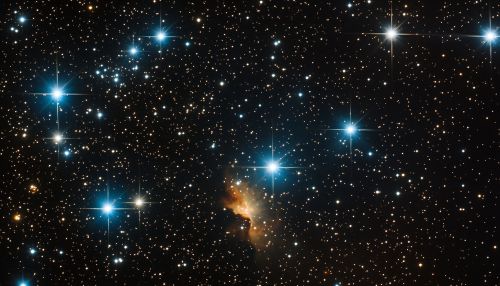Puppis: Difference between revisions
(Created page with "== Overview == '''Puppis''' is a constellation in the southern sky, representing the stern of the ship Argo Navis, which was divided into three separate constellations by Nicolas-Louis de Lacaille in the 18th century. The other two constellations are Carina (the keel) and Vela (the sails). Puppis is notable for its rich field of stars and deep-sky objects, making it a significant area of study in astronomy. ==...") |
No edit summary |
||
| Line 17: | Line 17: | ||
[[Rho Puppis]] is a yellow giant star with an apparent magnitude of 2.78. It is located about 63 light-years from Earth and is known for its rapid oscillations, making it a target for asteroseismology studies. | [[Rho Puppis]] is a yellow giant star with an apparent magnitude of 2.78. It is located about 63 light-years from Earth and is known for its rapid oscillations, making it a target for asteroseismology studies. | ||
[[Image:Detail-98017.jpg|thumb|center|Star field of the Puppis constellation, showing bright stars and nebulae.|class=only_on_mobile]] | |||
[[Image:Detail-98018.jpg|thumb|center|Star field of the Puppis constellation, showing bright stars and nebulae.|class=only_on_desktop]] | |||
== Deep-Sky Objects == | == Deep-Sky Objects == | ||
Latest revision as of 01:45, 20 September 2024
Overview
Puppis is a constellation in the southern sky, representing the stern of the ship Argo Navis, which was divided into three separate constellations by Nicolas-Louis de Lacaille in the 18th century. The other two constellations are Carina (the keel) and Vela (the sails). Puppis is notable for its rich field of stars and deep-sky objects, making it a significant area of study in astronomy.
History and Mythology
Puppis, as part of the larger Argo Navis, has its origins in Greek mythology. The Argo was the ship used by Jason and the Argonauts on their quest for the Golden Fleece. The constellation was first cataloged by the Greek astronomer Ptolemy in the 2nd century. In the 18th century, Lacaille divided Argo Navis into three smaller constellations to make it more manageable for astronomers to study.
Notable Stars
Puppis contains several notable stars, many of which are bright and easily observable with the naked eye or small telescopes.
Zeta Puppis (Naos)
Zeta Puppis is the brightest star in the constellation, with an apparent magnitude of 2.21. It is a blue supergiant and one of the most luminous stars in the Milky Way. Zeta Puppis is approximately 1,090 light-years from Earth.
Pi Puppis
Pi Puppis is a red supergiant star with an apparent magnitude of 2.71. It is part of the open cluster Collinder 135 and is approximately 810 light-years away from Earth.
Rho Puppis
Rho Puppis is a yellow giant star with an apparent magnitude of 2.78. It is located about 63 light-years from Earth and is known for its rapid oscillations, making it a target for asteroseismology studies.


Deep-Sky Objects
Puppis is rich in deep-sky objects, including star clusters, nebulae, and galaxies.
Messier 46
Messier 46 (M46) is an open cluster containing about 500 stars. It is located approximately 5,400 light-years from Earth and has an apparent magnitude of 6.1. M46 is notable for containing the planetary nebula NGC 2438, which appears superimposed on the cluster but is actually a foreground object.
Messier 47
Messier 47 (M47) is another open cluster, located about 1,600 light-years from Earth. It has an apparent magnitude of 4.4 and contains around 50 stars. M47 is relatively young, with an estimated age of 78 million years.
NGC 2451
NGC 2451 is an open cluster divided into two distinct groups, NGC 2451A and NGC 2451B. NGC 2451A is about 600 light-years away, while NGC 2451B is approximately 1,200 light-years distant. Both groups are visible with binoculars and small telescopes.
NGC 2477
NGC 2477 is an open cluster with an apparent magnitude of 5.8. It is located about 3,900 light-years from Earth and contains around 300 stars. NGC 2477 is considered one of the richest and most beautiful open clusters in the sky.
Observational Data
Puppis is best observed during the months of February and March when it is highest in the sky. The constellation is located in the Milky Way, making it a rich field for amateur and professional astronomers alike.
Coordinates
- Right Ascension: 7 hours
- Declination: -30 degrees
Visibility
Puppis is visible from latitudes between +40° and -90°. It is best viewed from the southern hemisphere, where it appears higher in the sky.
